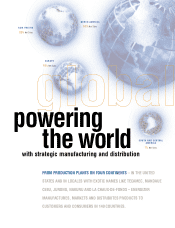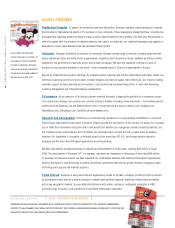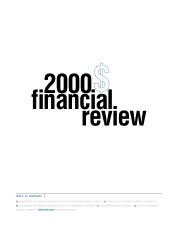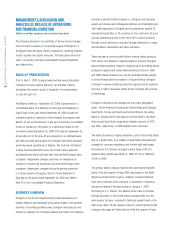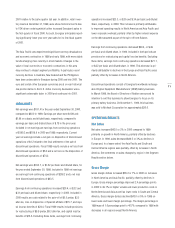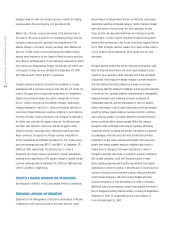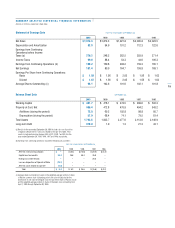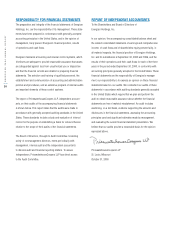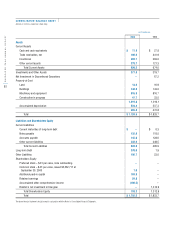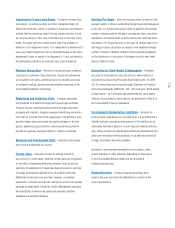Energizer 2000 Annual Report Download - page 19
Download and view the complete annual report
Please find page 19 of the 2000 Energizer annual report below. You can navigate through the pages in the report by either clicking on the pages listed below, or by using the keyword search tool below to find specific information within the annual report.
17
state-designated site. Liability under the applicable federal and state
statutes which mandate cleanup is strict, meaning that liability may
attach regardless of lack of fault, and joint and several, meaning that
a liable party may be responsible for all of the costs incurred in
investigating and cleaning up contamination at a site. However,
liability in such matters is typically shared by all of the financially
viable responsible parties.
The amount of Energizer’s ultimate liability in connection with those
sites may depend on many factors, including the volume and toxicity
of material contributed to the site, the number of other PRPs and
their financial viability, and the remediation methods and technology
to be used.
In addition, Energizer undertook certain programs to reduce or
eliminate the environmental contamination at the rechargeable
battery facility in Gainesville, Florida, which was divested in
1999. In the event that the buyer would become unable to continue
such programs, Energizer could be required to bear financial
responsibility for such programs as well as for other known and
unknown environmental conditions at the site.
Many European countries, as well as the European Union, have been
very active in adopting and enforcing environmental regulations. In
many developing countries in which Energizer operates, there has
not been significant governmental regulation relating to the environ-
ment, occupational safety, employment practices or other business
matters routinely regulated in the United States. As such economies
develop, it is possible that new regulations may increase the risk
and expense of doing business in such countries.
It is difficult to quantify with certainty the potential financial impact
of actions regarding expenditures for environmental matters, particu-
larly remediation and future capital expenditures for environmental
control equipment. Nevertheless, based upon the information cur-
rently available, Energizer believes that its ultimate liability arising
from such environmental matters, taking into account established
accruals of $3.6 for estimated liabilities, should not be material to
its financial position. Such liability could, however, be material
to results of operations or cash flows for a particular quarter or
annual period.
MARKET RISK SENSITIVE INSTRUMENTS
AND POSITIONS
The market risk inherent in Energizer’s financial instruments and
positions represents the potential loss arising from adverse changes
in interest rates and foreign currency exchange rates. The following
risk management discussion and the estimated amounts generated
from the sensitivity analyses are forward-looking statements of
market risk assuming certain adverse market conditions occur.
Interest Rates
Energizer has interest-rate risk with respect to interest expense on
variable rate debt. At September 30, 2000 and 1999, Energizer had
$330.0 and $120.7 variable rate debt outstanding. A hypothetical
10% adverse change in all interest rates would have had an annual
unfavorable impact of $2.6 and $.9 in 2000 and 1999, respectively,
on Energizer’s earnings and cash flows based upon these year-end
debt levels. The primary interest rate exposures on variable rate debt
are with respect to U.S. rates and short-term local currency rates in
certain Asian and Latin American countries.
Foreign Currency Exchange Rates
Energizer employs a foreign currency hedging strategy which
focuses on mitigating potential losses in earnings or cash flows on
foreign currency transactions, primarily anticipated intercompany
purchase transactions and intercompany borrowings. External pur-
chase transactions and intercompany dividends and service fees
with foreign currency risk are also hedged from time to time. The
primary currencies to which Energizer’s foreign affiliates are exposed
include the U.S. dollar, euro, Singapore dollar, Indonesian rupiah
and British pound, while domestic affiliates are primarily exposed
to the Swiss franc.
Energizer’s hedging strategy involves the use of natural hedging
techniques, where possible, such as the offsetting or netting of
like foreign currency cash flows. Where natural hedging techniques
are not possible, foreign currency derivatives with durations of gen-
erally one year or less may be used, including forward exchange
contracts, purchased put and call options, and zero-cost option
collars. Energizer policy allows foreign currency derivatives to be
used only for identifiable foreign currency exposures and, therefore,


